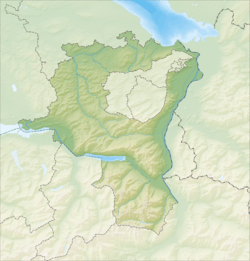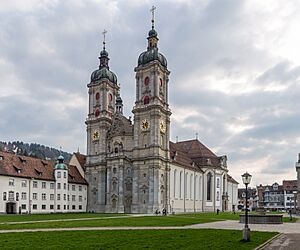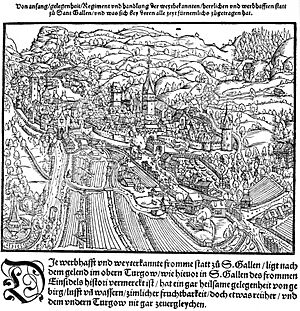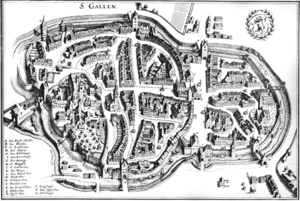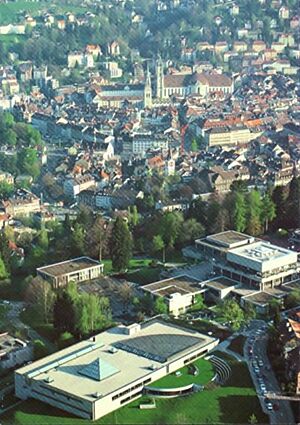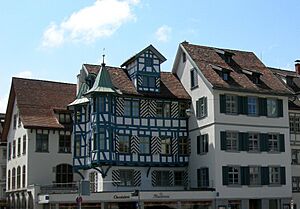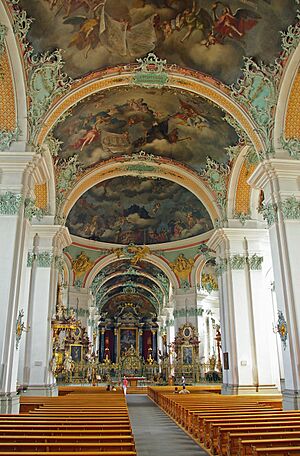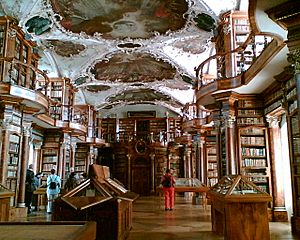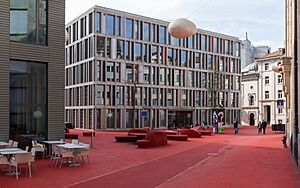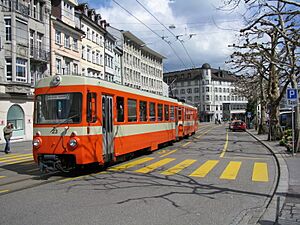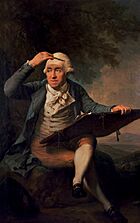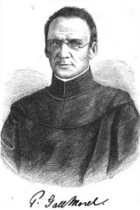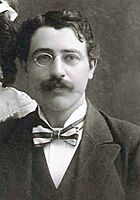St. Gallen facts for kids
Quick facts for kids
St. Gallen
|
||
|---|---|---|

A view of St. Gallen
|
||
|
||
| Country | Switzerland | |
| Canton | St. Gallen | |
| District | St. Gallen | |
| Area | ||
| • Total | 39.38 km2 (15.20 sq mi) | |
| Elevation
(Bahnhofsplatz)
|
669 m (2,195 ft) | |
| Highest elevation
(Birt)
|
1,074 m (3,524 ft) | |
| Lowest elevation
(Goldachtobel)
|
496 m (1,627 ft) | |
| Population
(Dec 2020 )
|
||
| • Total | 76,213 | |
| • Density | 1,935.32/km2 (5,012.5/sq mi) | |
| Demonym(s) | German: Sankt-Galler(in) | |
| Postal code |
9000, 9008, 9010-9012, 9014-9016 St. Gallen (partly: 9037 Speicherschwendi, 9042 Speicher)
|
|
| Localities | Wolfganghof, Winkeln, Bruggen, Lachen, Rosenberg, Riethüsli, St. Georgen, Innenstadt, St. Jakob, Linsenbühl-Dreilinden, Rotmonten, Langgass-Heiligkreuz, St. Fiden, Notkersegg, Neudorf, Achslen, Guggeien | |
| Surrounded by | Eggersriet, Gaiserwald, Gossau, Herisau (AR), Mörschwil, Speicher (AR), Stein (AR), Teufen (AR), Untereggen, Wittenbach | |
| Twin towns | Liberec (Czech Republic) | |
St. Gallen is a cool city in Switzerland. It's the capital of the St. Gallen canton. The city started way back in the 7th century around a place where a hermit named Saint Gall lived.
Today, St. Gallen is a big city in eastern Switzerland with about 167,000 people. Most of its jobs are in the service industry. It's also home to the University of St. Gallen, which is one of Europe's best business schools!
One of the most famous places to visit is the Abbey of Saint Gall. It's so important that UNESCO has named it a World Heritage Site. The Abbey's library has super old books from the 9th century! People in St. Gallen mostly speak a local kind of Swiss German. The city is well connected by transport to other parts of Switzerland and nearby countries like Germany and Austria. It's also a great starting point to explore the Appenzellerland mountains.
Contents
History of St. Gallen
How St. Gallen Began
The city of St. Gallen grew up around the Abbey of St Gall. This abbey was founded in the 8th century. Legend says it was built where an Irish missionary, Gallus, settled in 612 AD. The monastery itself was started by Saint Othmar around 720 AD.
The abbey became very successful in the 9th century. It was a popular place for pilgrims and a busy trading center. It even had one of the first monastery schools north of the Alps! By the 10th century, a town had formed around the abbey.
In 926, invaders called Magyars attacked the abbey and town. A woman named Saint Wiborada warned everyone to leave. The monks saved their treasures, but Wiborada stayed and was killed. A big fire in 937 burned much of the abbey and town, but luckily, the library was safe. Around 954, a protective wall was built around the abbey. By 975, this wall was finished, and the town of St. Gallen really started to grow.
Becoming Independent from the Abbey
Over time, the town of St. Gallen wanted to be free from the abbey's control. In 1180, an imperial officer was put in charge of the town, and he didn't answer to the abbot.
In 1207, the abbot was given the title of Imperial Prince. This made the Abbey of St. Gallen a powerful state in northern Switzerland.
But the city of St. Gallen kept trying to gain independence. By 1353, local groups, especially the cloth-weavers, were running the city government. In 1415, the city bought its freedom from the German king.
Joining the Swiss Confederation
In 1405, the areas around the abbey successfully rebelled. In 1411, they became allies of the Old Swiss Confederation. A few months later, St. Gallen city also joined them. The city became a full member of the Confederation in 1454. By 1457, it was completely free from the abbot's rule.
However, the abbey itself became an ally of some other Swiss cantons in 1451.
Ulrich Varnbüler was an early mayor of St. Gallen. He was a talented leader and represented St. Gallen in the Swiss parliaments. He was known for being smart and good at speaking.
In the late 1480s, Ulrich Varnbüler got into a big argument with the abbot, Ulrich Rösch. The abbot wanted to move the abbey to a new location by Lake Constance. This upset the people of St. Gallen and others nearby. Varnbüler led the protest against the abbot. On July 28, 1489, armed groups from St. Gallen destroyed the new buildings being built. This event was called the Rorschacher Klosterbruch.
The Invasion of 1490
Ulrich Varnbüler thought the Swiss cantons wouldn't get involved. But he was wrong. In 1490, four cantons sent an army to St. Gallen. The people of St. Gallen lost hope and agreed to a deal. This deal limited the city's power and made them pay a lot of money.
Ulrich Varnbüler had to escape the city in disguise. He fled to Germany. His actions, however, helped strengthen the bond between St. Gallen and the Swiss Confederation. This conflict also made the Swiss Confederation and the German Holy Roman Empire drift further apart.
Ulrich Varnbüler is remembered in a famous woodcut by the artist Albrecht Dürer.
The Reformation in St. Gallen
Around 1526, the mayor, Joachim von Watt (Vadian), brought the Protestant Reformation to St. Gallen. The city became Protestant, but the abbey stayed Roman Catholic. Even though people removed images from the city's churches, the strong abbey remained untouched. The abbey was a Catholic center in the Protestant city until 1803.
Modern History of St. Gallen
In 1798, the French invaded Switzerland. This changed everything. Both the abbey and the city lost their power. They were combined with another area to form a new canton. But this new government was not popular. In 1803, it was overthrown. St. Gallen then became the capital of the Protestant Canton of St. Gallen.
One of the first things the new canton did was close the abbey. The monks had to leave. In 1846, the abbey church became a cathedral for a new Catholic diocese.
St. Gallen became famous for making high-quality textiles in the 15th century. By 1714, they were making 38,000 pieces of cloth each year! The textile industry faced tough times later, but it always recovered.
In the early 1800s, the first embroidery machines were invented in St. Gallen. By 1910, embroidery was Switzerland's biggest export! More than half of the world's embroidery came from St. Gallen. About one-fifth of the people in eastern Switzerland worked in the textile industry. However, World War I and the Great Depression caused big problems for the industry. It only recovered a bit in the 1950s. Today, a smaller textile industry still exists, and St. Gallen's embroidered fabrics are still popular with fashion designers in Paris.
Geography and Climate
St. Gallen's Location
St. Gallen is in northeastern Switzerland. It sits in a valley about 700 meters (2,300 feet) above sea level. This makes it one of the highest cities in Switzerland, so it gets lots of snow in winter! The city is located between Lake Constance and the Appenzell Alps. The highest peak nearby is the Säntis, which is 2,502 meters (8,209 feet) tall. This means there are great places for outdoor fun nearby.
The city center is built on soft ground. Because of this, all buildings on the valley floor need strong foundations with piles. For example, the train station is built on hundreds of piles!
St. Gallen covers an area of 39.38 square kilometers (15.20 square miles). About 27.7% of this land is used for farming. Forests cover 28.2%, and 42.1% is covered by buildings or roads. The rest is rivers or lakes.
Weather in St. Gallen
St. Gallen has a climate with warm summers and long, moderately cold winters. It rains or snows a lot throughout the year. St. Gallen also tends to be very cloudy.
Between 1981 and 2010, St. Gallen had about 141 days of rain or snow each year. It received an average of 1,248 millimeters (49.1 inches) of rain. July was the wettest month, with about 172 millimeters (6.8 inches) of rain over 13.8 days. February was the driest month, with about 57 millimeters (2.2 inches) of rain over 9.1 days.
| Climate data for St. Gallen (1991–2020) | |||||||||||||
|---|---|---|---|---|---|---|---|---|---|---|---|---|---|
| Month | Jan | Feb | Mar | Apr | May | Jun | Jul | Aug | Sep | Oct | Nov | Dec | Year |
| Mean daily maximum °C (°F) | 2.9 (37.2) |
3.8 (38.8) |
7.9 (46.2) |
12.2 (54.0) |
16.5 (61.7) |
19.9 (67.8) |
21.7 (71.1) |
21.3 (70.3) |
16.8 (62.2) |
12.4 (54.3) |
7.0 (44.6) |
3.9 (39.0) |
12.2 (54.0) |
| Daily mean °C (°F) | 0.2 (32.4) |
0.8 (33.4) |
4.4 (39.9) |
8.1 (46.6) |
12.2 (54.0) |
15.7 (60.3) |
17.5 (63.5) |
17.2 (63.0) |
13.1 (55.6) |
9.2 (48.6) |
4.3 (39.7) |
1.3 (34.3) |
8.7 (47.7) |
| Mean daily minimum °C (°F) | −2.3 (27.9) |
−2.0 (28.4) |
1.0 (33.8) |
4.2 (39.6) |
8.2 (46.8) |
11.8 (53.2) |
13.6 (56.5) |
13.6 (56.5) |
9.9 (49.8) |
6.3 (43.3) |
1.6 (34.9) |
−1.6 (29.1) |
5.4 (41.7) |
| Average precipitation mm (inches) | 67 (2.6) |
64 (2.5) |
87 (3.4) |
103 (4.1) |
156 (6.1) |
170 (6.7) |
174 (6.9) |
185 (7.3) |
138 (5.4) |
105 (4.1) |
93 (3.7) |
90 (3.5) |
1,433 (56.4) |
| Average snowfall cm (inches) | 33 (13) |
45 (18) |
27 (11) |
10 (3.9) |
1 (0.4) |
0 (0) |
0 (0) |
0 (0) |
0 (0) |
3 (1.2) |
21 (8.3) |
37 (15) |
177 (70) |
| Average precipitation days (≥ 1.0 mm) | 10.6 | 9.4 | 12.0 | 11.3 | 13.5 | 13.8 | 13.4 | 12.8 | 11.6 | 10.5 | 10.5 | 11.6 | 141.0 |
| Average snowy days (≥ 1.0 cm) | 6.3 | 6.4 | 4.8 | 1.7 | 0.2 | 0.0 | 0.0 | 0.0 | 0.0 | 0.4 | 3.5 | 6.0 | 29.3 |
| Average relative humidity (%) | 80 | 76 | 72 | 68 | 71 | 72 | 71 | 74 | 79 | 81 | 82 | 80 | 76 |
| Mean monthly sunshine hours | 57 | 79 | 132 | 168 | 186 | 200 | 227 | 209 | 154 | 101 | 59 | 48 | 1,619 |
| Percent possible sunshine | 27 | 32 | 38 | 43 | 42 | 44 | 50 | 50 | 44 | 34 | 26 | 25 | 40 |
| Source: MeteoSwiss | |||||||||||||
International Friends
St. Gallen is twinned with:
|
People of St. Gallen
Population and Languages
| Largest groups of foreign residents 2019 | |
| Nationality | Numbers |
|---|---|
| 4,979 | |
| 2,713 | |
| 1,935 | |
| 1,339 | |
| 1,163 | |
| 1,144 | |
| 995 | |
| 894 | |
| 725 | |
| 707 | |
St. Gallen has a population of 76,213. As of 2019, about 31.4% of the people living there were from other countries. The population has been growing by about 4.4% each year.
Most people in St. Gallen (83.0%) speak German. Italian is the second most common language (3.7%), and Serbo-Croatian is third (3.7%).
How People Live
As of 2000, about 22.3% of people lived alone. About 23.6% were couples without children. And 38.5% were couples with children. About 6.2% of homes were single-parent families.
Historical Population Trends
The table below shows how the population of St. Gallen has changed over time:
| year | population | Swiss Nationals | % German Speaking | % Italian Speaking | % Romansh Speaking | % Protestant | % Roman Catholic | ||||||||
|---|---|---|---|---|---|---|---|---|---|---|---|---|---|---|---|
| 1411 | ca. 2,300–2,900 | ||||||||||||||
| about 1500 | ca. 3,000–4,000 | 1680 | ca. 6,000 | ||||||||||||
| 1766 | ca. 8,350 | ||||||||||||||
| 1809 | 8,118 | ||||||||||||||
| 1837 | 9,430 | ||||||||||||||
| 1850 | 17,858 | 16,529 | 50.4% | 49.3% | |||||||||||
| 1870b | 26,398 | 23,805 | 49.8% | 49.9% | |||||||||||
| 1888 | 43,296 | 34,168 | 97.5% | 1.4% | 0.5% | 49.0% | 49.7% | ||||||||
| 1900 | 53,796 | 40,342 | 94.9% | 3.6% | 0.7% | 46.8% | 52.1% | ||||||||
| 1910 | 75,482 | 50,582 | 88.7% | 9.5% | 0.8% | 43.5% | 54.2% | ||||||||
| 1930 | 63,947 | 52,679 | 95.9% | 2.5% | 0.8% | 48.5% | 49.0% | ||||||||
| 1950 | 68,011 | 61,009 | 95.4% | 2.6% | 1.0% | 49.3% | 47.8% | ||||||||
| 1970 | 80,852 | 66,270 | 86.3% | 8.6% | 0.8% | 42.1% | 55.1% | ||||||||
| 1990 | 75,237 | 58,300 | 82.4% | 5.6% | 1.1% | 35.1% | 50.8% | ||||||||
| 2000 | 72,626 | 53,132 | 83.0% | 3.7% | 0.8% | 28.9% | 44.0% |
Jobs and Economy
In 2007, St. Gallen had a low unemployment rate of 2.69%. Many people work in the service industry, like in offices or shops. There are also jobs in manufacturing and farming. Helvetia Insurance is a big company with its main office in St. Gallen.
Religion in St. Gallen
According to a 2000 survey, about 44.0% of people in St. Gallen were Roman Catholic. About 27.0% belonged to the Swiss Reformed Church (Protestant). There are also people who belong to the Orthodox Church, other Christian churches, and the Muslim faith. About 9.94% of the population said they didn't belong to any church.
Education in St. Gallen
St. Gallen is famous for its business school, the University of St. Gallen (HSG). It's considered one of the best business schools in Europe! HSG offers degrees in business, economics, political science, and law. It's a smaller university with about 6,500 students. It's also known for its many student clubs. The International Students’ Committee organizes the St. Gallen Symposium, a big student-run conference that brings together leaders from around the world.
St. Gallen has 64 kindergartens, 21 primary schools, and 7 secondary schools. About 6,800 students attend these schools. There's also a special boarding school called the Institut auf dem Rosenberg. Students from all over the world go there to prepare for universities in different countries.
Many adults in St. Gallen (about 68.8%) have finished high school or gone on to higher education like university.
Culture and Things to See
St. Gallen has a rich culture, thanks to the creative monks who lived there long ago. Many buildings and places in the city are considered important national treasures.
In 1992, St. Gallen won the Wakker Prize. This award recognized the city's efforts to keep its buildings and new constructions looking good and fitting together.
Important Heritage Sites
St. Gallen has 28 sites listed as Swiss heritage sites of national significance. These include:
- Four religious buildings: the Abbey of St. Gallen, the former Dominican Abbey of St. Katharina, the Reformed Church of St. Laurenzenkirche, and the Roman Catholic parish church of St. Maria Neudorf.
- Six museums or archives: the Textile museum, the Historical and ethnographical museum, the Cantonal library and city archives, the Art and Natural History museum, the Museum in Lagerhaus, and the St. Gallen State Archive.
- The entire city of St. Gallen is an important archaeological site.
- Two bridges: the Eisenbahnbrücke BT (railroad bridge) and the Kräzern-Strassenbrücke with a custom house.
- Other sites include the main train station, main post office, University of St. Gallen, Cantonal School, City Theatre, and two towers.
Theatre and Music
- The Theater St. Gallen is a modern building where you can watch operas, ballets, musicals, and plays.
- In summer, open-air operas are performed in front of the Cathedral.
- The Tonhalle St. Gallen is a beautiful concert hall where all kinds of music concerts are held.
- The famous St. Gallen Open Air Festival happens every July in the nearby Sitter Valley.
- St. Gallen also hosts the Nordklang Festival in February.
Museums to Explore
- Historical and ethnographical museum: Learn about the region's early history, the city's past, and folk art.
- Art museum: See paintings and sculptures from the 19th and 20th centuries.
- St. Gallen art gallery: Discover national and international modern art.
- Natural history museum: Explore collections about nature.
- Museum in the storehouse: See Swiss native art and unique art brut.
- Textile museum: Look at historical laces, embroidery, and cloth.
- Lapidarium of the abbey: See old building blocks from the 8th to 17th centuries.
- Point Jaune museum: A fun museum about Mail Art.
- Beer bottle museum: Located at the oldest brewery in Switzerland!
Cool Buildings and Places
- Drei Weieren (Three Ponds): These are three artificial pools from the time of the textile industry. They have cool Art Nouveau bathhouses. You can reach them by a train called the Mühleggbahn. The Drei Weieren is a water park during the day and a popular spot for young people at night.
- Convent of St. Gall: This includes the famous library and abbey, which is a UNESCO World Heritage Site.
- Greek Orthodox Church of St.Constantine and Helena: Features beautiful icons and a stained glass window.
- Wegelin & Co.: The oldest bank in Switzerland, started in 1741.
- Tröckneturm Schönenwegen: A tower built in 1828 to dry freshly colored cloth.
- Protestant church Linsebühl: An impressive building from 1897.
- University of St. Gallen (HSG): A well-known university for business, economics, and law.
- Embroidery exchange: A grand building with the god of trade, Hermes, on its roof.
- Volksbad: The oldest public bathhouse still open in Switzerland, from 1908.
- Catholic church of St. Martin: A modern concrete church built in 1936.
- Stadtlounge (City Lounge): A pedestrian area in the city center designed to look like a living room!
- Synagogue St. Gallen: The only synagogue in the Lake Constance area that still looks like it did when it was built.
Parks to Relax In
- Wildlife park Peter and Paul
- City park near the theater
- Cantonal school park
Regular Events
- The St. Gallen Symposium brings together about 600 important people from business, science, and politics at the University of St. Gallen every year. It also has a huge student essay competition.
- OLMA: A traditional Swiss fair for agriculture and food in autumn.
- OpenAir St. Gallen: An annual open-air music festival in the Sitter Valley.
- Children's Feast: A festival held every three years, which started because of the textile industry.
- Nordklang Festival: A music festival that takes place in different spots around St. Gallen.
Sports in St. Gallen
- The football club FC St. Gallen plays in the top Swiss league. They are the oldest football club in Switzerland, founded in 1879! Their stadium is the kybunpark.
- Another football club, SC Brühl, also plays in St. Gallen.
- The EHC St. Gallen plays ice hockey in the Swiss Second League.
- The Rugby Club St. Gallen Bishops (for men) and Cindies (for women) play at the Grundenmoos sports fields.
Getting Around St. Gallen
The big city of Zürich is about 80 kilometers (50 miles) southwest of St. Gallen. You can get there in about an hour by car or by train.
Road Travel
The A1 motorway connects St. Gallen to other cities like Zürich and Geneva. In 1987, a city motorway was opened. It sends traffic through two tunnels right under the city center.
Air Travel
The Airport St. Gallen-Altenrhein, near Lake of Constance, has flights to places like Vienna.
Public Transport
Trains and Trams
St. Gallen railway station is a main hub for trains. You can catch InterCity trains to Zürich and the Zurich Airport every half-hour. St. Gallen is also a center for many smaller private railways. For example, the Appenzeller Bahnen connects St. Gallen to Appenzell and Trogen, and it even acts like a tram in downtown St. Gallen.
Buses
The city has a great local bus system, including trolleybuses. These buses are good for getting around the valley floor. Since St. Gallen is near the Appenzell mountains, there are also many Postauto (post bus) connections that go to the mountain areas. The area around St. Gallen also has its own St. Gallen S-Bahn system, which are local trains.
Future Plans for Transport
The "St. Gallen 2013" project aimed to make local train services even better. This included upgrading the tracks and getting new trains. By December 2013, the S-Bahn trains were running on six lines, coming every 15 to 30 minutes.
Famous People from St. Gallen
Historical Figures
- Joachim Vadian (1484–1551): A smart scholar, mayor, and reformer in St. Gallen.
- Georg Gsell (1673–1740): A painter and art expert.
- Adrian Zingg (1734–1816): A painter and engraver.
- Johann Baptist Isenring (1796–1860): A landscape painter and early photographer.
19th Century Figures
- Gall Morel (1803–1872): A poet and scholar.
- Arnold Otto Aepli (1816–1897): A lawyer and politician.
- Johann Jakob Weilenmann (1819–1896): A mountaineer and writer.
- Karl Hoffmann (1820–1895): A politician who was President of the Swiss Council of States.
- Robert Emden (1862–1940): An astrophysicist.
- Julius Billeter (1869–1957): A genealogist.
- Martha Cunz (1876–1961): An artist known for her woodcuts.
- Heinrich Greinacher (1880–1974): A physicist.
- Paul Scherrer (1890–1969): A physicist.
- Karl Kobelt (1891–1968): A politician who was President of the Confederation.
- Paul Grüninger (1891–1972): A police captain honored for saving lives during WWII.
- Walter Mittelholzer (1894–1937): A pioneer in aviation, pilot, and photographer.
20th and 21st Century Figures
- Berta Rahm (1910–1998): An architect, writer, and feminist.
- Peter Maag (1919–2001): A conductor.
- Walter Roderer (1920–2012): An actor and screenwriter.
- Kurt Furgler (1924–2008): A politician.
- Fred Hayman (1925–2016): An American fashion retailer.
- Hansrudi Wäscher (1928–2016): A Swiss-German comics artist.
- Ines Torelli (1931–2019): A comedian and actress.
- Ruth Dreifuss (born 1940): A politician who was a member of the Swiss Federal Council.
- Dieter Mobius (1944–2015): A German electronic musician.
- Paola del Medico (born 1950): A singer.
- Simone Drexel (born 1957): A singer and songwriter.
- Maria Pappa (born 1971): A politician.
- Marco Zwyssig (born 1971): A football player.
- Dominik Meichtry (born 1984): A swimmer.
- Tranquillo Barnetta (born 1985): A football player.
- Nevin Galmarini (born 1986): An Olympic snowboarder.
- Linda Fäh (born 1987): A model and Miss Switzerland 2009.
- Marwin Hitz (born 1987): A professional football player.
- Jolanda Neff (born 1993): A cross-country cyclist.
- Kevin Fiala (born 1996): An ice hockey player.
See also
 In Spanish: San Galo para niños
In Spanish: San Galo para niños




